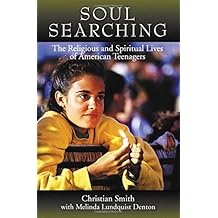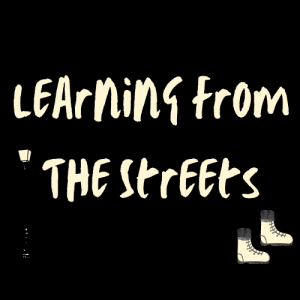There were 10 main points in the conclusion to ‘Soul Searching: The Religious and Spiritual lives of American Teenagers’ by Christian Smith, but the main headline from the book referred to the concept of MTD.
 Between 2001 and 2005 , the National Study of Youth and Religion in American undertook research into the Spiritual lives of young people aged between 11-17, they conducted interviews, focus groups, and telephone conversations with young people all across the USA.
Between 2001 and 2005 , the National Study of Youth and Religion in American undertook research into the Spiritual lives of young people aged between 11-17, they conducted interviews, focus groups, and telephone conversations with young people all across the USA.
Whilst MTD got the headlines, and has been referred to in a number of publications, it is some of the other conclusions within the research that might be of equal interest to Youth Ministers, clergy, volunteers and parents of young adults, especially in the UK.
Ill get to MTD later.
So, after listening to and dissecting the information from the research, these were Christian Smiths conclusions regarding the spirituality of American young people:
- Religion is important: Religion is a significant presence in the lives of young people. Most have not dropped out of the religious congregations they were raised. Many profess religion to be important and has influence over moral choices. They might not be able to articulate their beliefs that well, but they do have some kind of religious identity.
- Young people arent as rebellious as we think! The Character of most young adults is extraordinarily conventional, they follow the religion of their parents in the vast majority of cases.
- Religion or no religion – spirituality is not the question; As part of religious conventionality, very few young people express a desire to be ‘spiritual and not religious’ many grant others right to persue religions, but few would be interested in doing this themselves. What they were raised with, religion or no religion is what they are most happy with.
- The USA is still predominately Christian; The shift in religious observance in 2001-2005 was of no significant difference to the previous 20, 30 or 40 years. Any claim to the alternative – ie the influx of Muslims, is simply overblown.
- Some religions are better than others at ‘helping’ young people; From a sociological perspective the young people who score highest on self esteem, and life choice factors were Mormons young people, conservative protestant and black pentecostal teenagers. It was identified that consequance and causality are reasons not to make astute claims, in this regard, and religions cant be compared like for like, however, from the data these three religions had a more positive effect on young people.
- Parents, Parents,Parents! The single most important social influence on the religious and spiritual life of a young person is their parents.
- Invest in training youth leaders! The greater the amount of religiously grounded relationships, activities, programmes, opportunities and challenges available to teenagers, the more likely teenager will be religiously engaged and interested. Religious communities that invest in training their leaders, teach adolescents are more likely to draw youth into their religious lives. The opposite is also the case, less investment by a church (not just financial investment) then young people are less likely to invest in their religious faith.
- I cant explain what i believe – I just do! Most US young people have difficulty articulating their faith, what it means and the implications of their faith on their lives. Many say they have no religious beliefs. Religion may play a part in a young persons life, but it seems confused, un-focussed and in the background, valued but not invested in, praised but not describable. Research pointed to a view that teaching and educating beliefs was weak.
- MTD has taken root! It is the new religion that is now worshipped within many of the main religious traditions. What is MTD? – it is Moral Therapeutic Deism – The belief that God merely gives, God expects moral behaviour, and that God is distant. MTD is covered in more detail here: http://wp.me/p2Az40-KS – If ‘God’ helps a person ‘feel happy’, or ‘confident’, or ‘helps me do what i want’- then these are possible symptoms. God exists and watches, God wants people to be nice, fair and good, being happy and feeling good is central to life, God is only required when theres a problem to take care of needs and good people go to heaven – these were all central beliefs of young people and form the basis of MTD.
- Religion takes place in a social context – and these are powerful influences. The choices of a young person are very powerfully influenced by forces outside of religion, and where religion is adhered to is still marginal then it becomes v difficult for a young person to see these powerful influences and the influence they have. Expectations are that young people go against the flow, half the time they are powerless to even swim.
- Religious life is important and has a positive effect on YP; religious young people are not the same as non-religious, there are differences in life outcomes between adherents and non adherents, as religions ( nearly all religions) shape and influence a young persons life. The culture of religious practices has an effective influence.
Recommendations;
- Adults to help to understand to socialisation process a young person is going through, including the socialisation process in a faith community – rather than see the young person as controller of their own desitiny, more often they are being shaped by forces outside of their control
- Young People are not alien creatures, are less dissimilar than like adults. They are more unlike their 3 year old younger sister than us their parent. The continuities are far more prevalent than distinctions. There is no need to research youth culture.
- Adults need to be reminded of the similarities with young people.
These recommendations are squared at adults in churches where there can be unseen but said barriers to working and involving themselves with young people.
“Religious organisations and congregations are uniquely positioned to embrace, connect and strengthen links between adults and teenagers, though it will require intentionality and investment “- concludes Christian Smith.
What might Christian Smith have highlighted that might be of relevance to the UK youth ministry, the North East Youth Ministry, 12 years later in 2017?
Does it represent a different culture that of the USA and so some of this is barely relevant at all? –
How might faith be something young people receive as being something ‘good for them’ but it not require sacrifice, a change in lifestyle, or discipleship.
How well to UK young people articulate faith and beliefs? What they actually believe about God? not just a moral opinion on gay marriage or abortion?
Just a few further questions from what was a fascinating read. MTD may have got the headlines, but theres at least 10 other helpful conclusions from Soul Searching that are good discussion starters in UK youth Ministry.
Thoughts?

